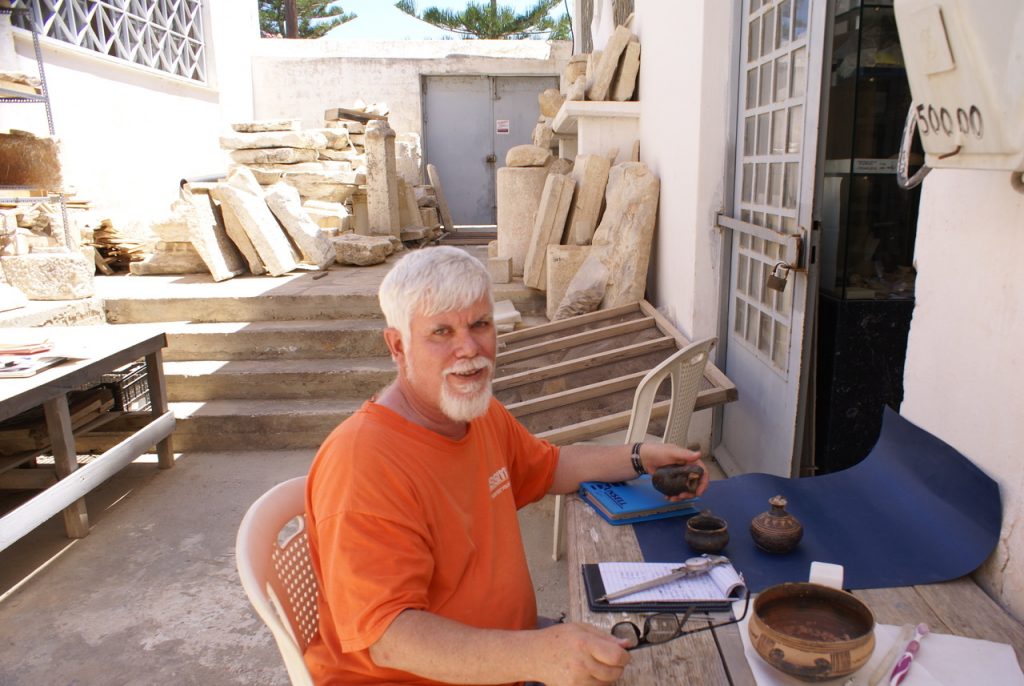June 21, 2022

This month, we’re excited to spotlight Robert F. Sutton of the Philadelphia Society. Robert, or Bob as he’s more commonly referred to, is the President of the Philadelphia Society and a long-time friend of the AIA. He’s the former Director of the Classical Studies Program at Indiana University Purdue University Indianapolis (IUPUI) and has served on multiple AIA committees and within different AIA Societies. We asked Bob some questions about his interest in archaeology and how he got involved with the AIA and we’re excited for you to read his words!
What interests you about archaeology?
Growing up in Philadelphia, I have always loved archaeology for offering a material and visual record of the human past around the world, an enduring interest that gradually eclipsed dinosaurs at a very young age. I was initially drawn by the Penn Museum’s Egyptian mummies and artifacts, a still remembered (French?) movie about a boy and elephant in Angkor Wat, and especially the museum’s weekly TV show What in the World, where archaeologists and anthropologists were asked to identify and explain a variety of ethnographic and archaeological objects from the collection. Later, I was attracted to the range of architecture, artifacts, and especially the imagery of Mayan and Inca cultures, early humans, Stonehenge, Mediaeval Europe, and the Classical World. They all offered separate gateways to understanding our varied past, an addictive record of what it has meant to be human over the millennia.
As a student and professional working in Italy & primarily in Greece I have enjoyed visiting ancient sites, examining and handling ancient objects in museums, and especially participating in excavations and surface surveys, where I have helped reassemble and interpret our new discoveries to present and explain them to colleagues, students, and the wider public. As an expert on ancient pottery, my work has had a dual focus: a) Working to process and identify the abundant pottery recovered from excavations and surface surveys; even single battered fragments can provide useful evidence for dating and understanding various functions of a site’s components. b) Interpreting aspects of gender presented in hundreds of painted scenes of ancient life that decorate fine Athenian pottery; widely traded throughout the Mediterranean and beyond for over half a millennium, these vivid images offer a useful complement to surviving texts for understanding ancient life.
How did you find out about the AIA?
I joined the Philadelphia Society in 1967 as a starting archaeology major in the Bryn Mawr College department at the urging of Prof. Bruni Ridgway, and was initially drawn by the National Lectures and subscriptions to AJA andArchaeology. Later, I also benefitted from attending the Annual Meetings to hear and deliver papers, connect with colleagues, and participate in the Career Placement Service as I continued my AIA membership as a graduate student at UNC-Chapel Hill (North Carolina (Triangle Area) Society) and later as faculty in the Tallahassee, Chicago, and Central Indiana Societies, before returning to Philadelphia in retirement.
What made you decide to get more involved with the Philadelphia Society?
I had become more involved earlier and twice served as President of the Central Indiana Society and helped expand our programming from Bloomington to also include Indianapolis and elsewhere. Our three annual National Lectures strongly enhanced local offerings while offering an excellent opportunity for faculty, students at a range of schools, and members of the general public to regularly interact with each other and lecturers; one of our members even regularly offered to pick up the check at dinners before lectures. I also served on the both the Program for the Annual Meeting Committee and Lecture Program Committee, excellent opportunities to shape both programs and collaborate with colleagues with varied specialties across the country; in the interests of professional diversity, I stepped down from both after six years.
Later, when I retired to Philadelphia, coming full circle, I was invited to serve as President in my original Society, one of the AIA’s largest and most active. Here, I have enjoyed working with colleagues in several major programs at local universities and colleges. The opportunity to coordinate our programming with the centrally located Penn Museum has offered the chance to work with the institution that first drew me to the field as a child almost seventy years ago. The abundance of lectures available at local universities and colleges has encouraged us to extend our AIA lectures beyond the Mediterranean and Near East to regularly include, for example, lectures on Vikings, sub-Saharan Africa, and Cambodia. Collaborating with the museum on International Archaeology Day draws varied crowds with the opportunity to hear lectures, examine ancient materials behind the scenes and outside the case, and outdoors an Indiana Jones treasure hunt that offers even the very young the opportunity to experience the excitement of archaeological discovery as they also flee a 10-foot-tall beach ball that rolls down from above. Recently, Covid restrictions have forced us all to move lectures, at first totally online and now to hybrid, but the change also drew viewers from across the nation and around the world. It is encouraging to see that the AIA’s National Lecture Program will now offer us many more lectures online while still sending lecturers in person. Our Society may experiment with continuing to meet to view at least some together, possibly at different locations, to maintain a regular opportunity to meet, discuss, and socialize throughout the year.
Notifications